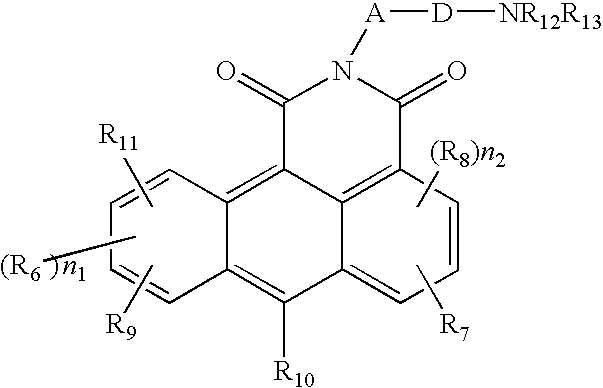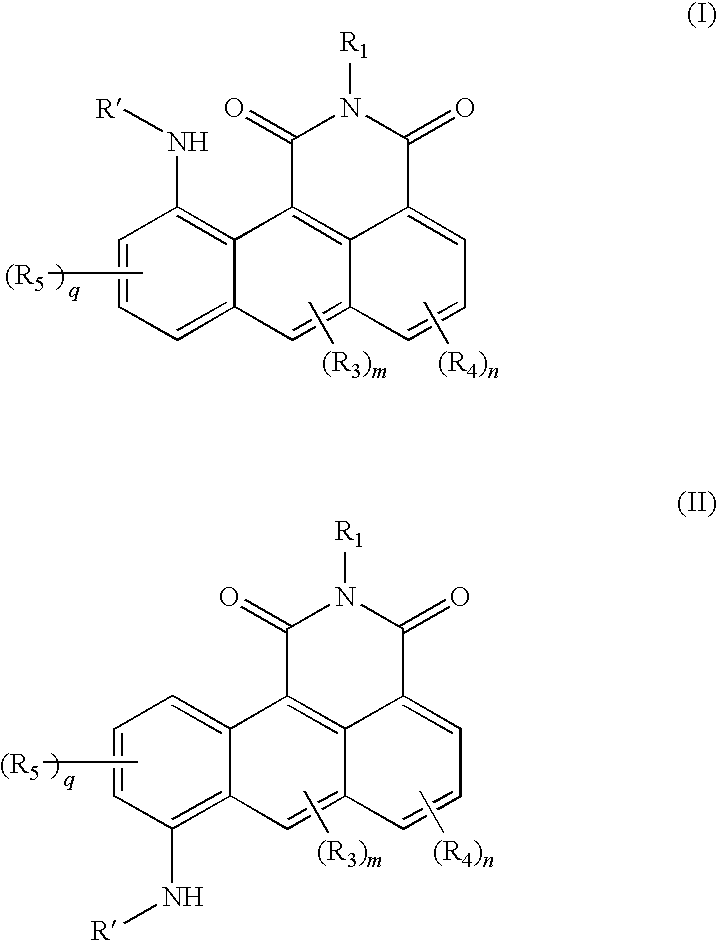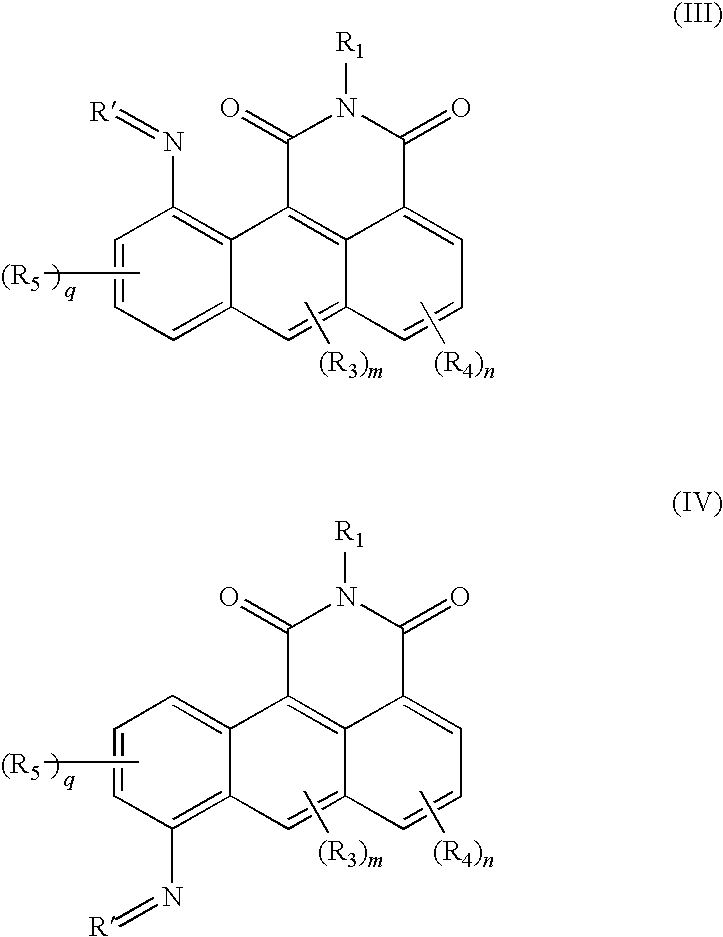Azonafide derivatives, methods for their production and pharmaceutical compositions therefrom
a technology of azonafide and derivatives, which is applied in the field of new substituted 1, 2dihydro3hdibenzisoquinoline1, 3dione derivatives, can solve the problem that amonafide had only moderate activity in leukemia, and achieve the effect of reducing the colonization of new tissues
- Summary
- Abstract
- Description
- Claims
- Application Information
AI Technical Summary
Benefits of technology
Problems solved by technology
Method used
Image
Examples
example 1
Preparation of 8- and 11-nitro-1,9-dicarboxylic-anhydride-anthracene
[0168]This method is based on the teaching of example 9 of U.S. Pat. No. 5,635,506 and proceeds according to the reaction shown below:
[0169]
[0170]A mixture of 1.010 g (4.07 mmol) of 1,9-dicarboxylic-anhydride-anthracene in 30 mL of concentrated sulfuric acid was stirred at −12° C. before adding 358 mg (1 molar equivalent) of 65% nitric acid (in 1 mL of sulfuric acid). The resulting mixture was stirred during 15 minutes and then was poured in 100 mL of iced water. The resulting yellow solid was filtrated, washed and dried. The dry solid product (1.100 g, yield: 91%) was determined by NMR 1H spectra analysis to be a mixture of two regioisomers which were not easily separable at this stage and were used in the following reaction without further purification.
example 2
Preparation of a Mixture of 2-[2-(dimethylamino)ethyl]-11-nitro-1H-dibenzo[de,h]isoquinoline-1,3(2H)-dione and 2-[2-(dimethylamino)ethyl]-8-nitro-1H-dibenzo[de,h]isoquinoline-1,3(2H)-dione
[0171]This method is based on the teaching of example 10 of U.S. Pat. No. 5,635,506 and proceeds according to the reaction shown below:
[0172]
[0173]A suspension of 1.4 g (4.78 mmol) of the mixture of 8- and 11-nitro-1,9-dicarboxylic-anhydride-anthracenes (obtained in example 1) in 100 mL of toluene and 20 mL of ethanol was treated with 0.630 ml (1.2 molar equivalent) of N,N-dimethyl-aminopropyldiamine. The mixture was refluxed for 3 hours until it could be determined by thin layer chromatography (TLC) that the starting product mixture had disappeared. The mixture was then evaporated and the resulting residue was submitted to a flash chromatography on silica (eluent CH2Cl2 / methanol in a 95:5 volume ratio) to give 1.230 g (yield: 70%) of a mixture of the two regioisomers respectively substituted in po...
examples 3 and 4
Preparation of 11-amino-2-[2-(dimethylamino)ethyl]-1H-dibenzo[de,h]isoquinoline-1,3(2H)-dione and 8-amino-2-[2-(dimethylamino)ethyl]-1H-dibenzo[de,h]isoquinoline-1,3(2H)-dione
[0174]This method is based on the teaching of example 12 of U.S. Pat. No. 5,635,506 and proceeds according to the reaction shown below:
[0175]
[0176]A suspension of 1.230 g (3.35 mmol) of a mixture (obtained in example 2) of 2-[2-(dimethylamino)ethyl]-11-nitro-1H-dibenzo[de,h]isoquinoline-1,3(2H)-dione and 2-[2-(dimethylamino)ethyl]-8-nitro-1H-dibenzo[de,h]isoquinoline-1,3(2H)-dione and 887 mg (0.25 molar equivalent) of a palladium / carbon hydrogenation catalyst in 60 mL of ethanol was stirred at 20° C. 12 mL of cyclohexene were then added before refluxing the resulting mixture during 18 hours. 887 mg of the catalyst were then added again and reflux was prolonged during 8 hours. The reaction mixture was then cooled, filtered on Celite and washed by 2 L of a solution of CH2Cl2 / methanol in a 1 / 1 ratio. The solvent w...
PUM
| Property | Measurement | Unit |
|---|---|---|
| temperatures | aaaaa | aaaaa |
| temperatures | aaaaa | aaaaa |
| molar ratio | aaaaa | aaaaa |
Abstract
Description
Claims
Application Information
 Login to View More
Login to View More - R&D
- Intellectual Property
- Life Sciences
- Materials
- Tech Scout
- Unparalleled Data Quality
- Higher Quality Content
- 60% Fewer Hallucinations
Browse by: Latest US Patents, China's latest patents, Technical Efficacy Thesaurus, Application Domain, Technology Topic, Popular Technical Reports.
© 2025 PatSnap. All rights reserved.Legal|Privacy policy|Modern Slavery Act Transparency Statement|Sitemap|About US| Contact US: help@patsnap.com



